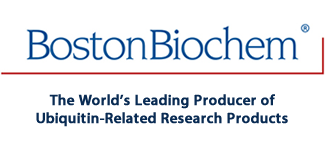
Recombinant Human Linear Tetra-Ub Non-hydrolyzable, CF Summary
Each Ubiquitin contains a Pro substitution at position 73.
Product Datasheets
Carrier Free
CF stands for Carrier Free (CF). We typically add Bovine Serum Albumin (BSA) as a carrier protein to our recombinant proteins.Adding a carrier protein enhances protein stability, increases shelf-life, and allows the recombinant protein to be stored at a more dilute concentration.The carrier free version does not contain BSA.
In general, we advise purchasing the recombinant protein with BSA for use in cell or tissue culture, or as an ELISA standard.In contrast, the carrier free protein is recommended for applications, in which the presence of BSA could interfere.
UCN-710
| Formulation | Lyophilized from a solution in deionized water. |
| Reconstitution | Reconstitute at 2 mg/ml in aqueous buffer. |
| Shipping | The product is shipped at ambient temperature. Upon receipt, store it immediately at the temperature recommended below. |
| Stability & Storage: | Use a manual defrost freezer and avoid repeated freeze-thaw cycles.
|
Reconstitution Calculator
Background: Tetra-Ubiquitin
With a predicted molecular weight of 34 kDa, Tetra-Ubiquitin chains are composed of four Ubiquitin monomers that are covalently linked through isopeptide bonds, which typically form between a lysine residue of one Ubiquitin molecule and the C-terminal glycine residue of another Ubiquitin molecule (1). Each human Ubiquitin monomer is 76 amino acids (aa) in length and shares 96% and 100% aa identity with yeast and mouse Ubiquitin, respectively (2). Seven of the 76 aa in Ubiquitin are lysine residues that can participate in poly-Ubiquitin chain formation. Linkage through specific lysine residues is thought to serve as a signal that affects protein degradation, signaling, trafficking, and other cellular processes (3-8).
This linear Ubiquitin fusion protein is resistant to the activity of deubiquitinatingenzymes (DUB"s) that cleave the peptide linkage between adjacent Ubiquitin molecules. Ubiquitin is not expressed directly as free Ubiquitin, but rather as linear fusions either to itself or to certain ribosomal protein subunits. These Ubiquitin-fusion precursors are proteolyzed by DUB"s at the appropriate junction points to yield active Ubiquitin monomers with C-termini ending in GG. There are likely several intracellular DUB"s which perform this essential processing role. This protein may be useful in analyzing interactions between linear Ubiquitin and proteins that contain Ubiquitin-associated domains (UBA"s) or Ubiquitin-interacting motifs (UIM"s).
- Scheffner, M. et al. (1995) Nature 373:81.
- Sharp, P.M. & W.-H. Li (1987) Trends Ecol. Evol. 2:328.
- Behrends, C. & J.W. Harper (2011) Nat. Struct. Mol. Biol. 18:520.
- Greene, W. et al. (2012) PLoS Pathog. 8:e1002703.
- Henry, A.G. et al. (2012) Dev. Cell 23:519.
- Tong, X. et al. (2012) J. Biol. Chem. 287:25280.
- Wei, W. et al. (2004) Nature 428:194.
- Zhang, J. et al. (2012) J. Biol. Chem. 287:28646.
FAQs
No product specific FAQs exist for this product, however you may
View all Proteins and Enzyme FAQsRecombinant Enzymes
Recombinant Human His6-USP7 Protein, CF
Recombinant Human His6UBE2S Protein, CF
Recombinant Human Isopeptidase T/USP5 Protein, CF
Recombinant Human STAM-1 Protein, CF
Recombinant Human Ubiquitin Activating Enzyme (UBE1), CF
Recombinant Human His6-UBE2N/UBE2V2 Complex Protein, CF
Recombinant Human His6-UAF1 Protein, CF
Recombinant Human UCH-L3 Protein, CF
Recombinant Human UBE2K/E2-25K Protein, CF
Reconstitution Buffers
Reconstitution Buffer 1 (PBS)
Reviews for Recombinant Human Linear Tetra-Ub Non-hydrolyzable, CF
There are currently no reviews for this product. Be the first toreview Recombinant Human Linear Tetra-Ub Non-hydrolyzable, CF and earn rewards!
Have you used Recombinant Human Linear Tetra-Ub Non-hydrolyzable, CF?
Submit a review and receive an Amazon gift card.
$25/€18/£15/$25CAN/¥75 Yuan/¥1250 Yen for a review with an image
$10/€7/£6/$10 CAD/¥70 Yuan/¥1110 Yen for a review without an image
ebiomall.com






>
>
>
>
>
>
>
>
>
>
>
>
加样缓冲液的主要作用是使PCR产物与其混合,
使DNA沉于加样孔的底部,防止DNA跑出来.
蛋白质上样缓冲液中的SDS和DTT分别可以屏蔽蛋白质电荷以及破坏二硫键,避免形成多聚体。
DNA上样缓冲液主要是起沉降和指示作用,不可用于蛋白,否则会影响蛋白相对分子量定量。
同样蛋白上样缓冲液中的tris-HCl浓度过高也会使溴酚蓝条带扭曲。









